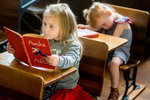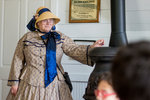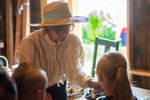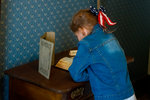



Residents of Centralia can’t quite transport themselves all the way back to 1776 as they celebrate the Fourth of July, but if they visit the southernmost portion of Borst Park, they can get pretty close.
Independence Day has always been the busiest day each year for the volunteers who put on the living history open house events at the trio of historic structures there: the Borst Home, carriage house and one-room schoolhouse. Many of the docents wore period clothing on Thursday as they led tours of the compound that serves as a tangible reminder of how the Hub City came to be.
“It’s important for us to do this, because otherwise the kids don’t learn about it all in school,” said Bonnie Cox, who joined Beverly York in overseeing the schoolhouse on Thursday. “I hope everyone who comes inside here can take away a little something. You can learn a lot even in just five minutes, and hopefully it instills a desire to learn more.”
Joseph and Mary Borst, one of the first families to settle in the area, built their home in about 1860. The City of Centralia paid $20,000 for the house in 1921 and later acquired the land that became Borst Park. Local organizations such as the Lewis County Retired Teachers Association worked with the city to build a replica of an old schoolhouse adjacent to the home in 1996. Construction of a replica one-room church from the same time period is nearly complete.
Nearly 150 years later, people of all ages wandered through the buildings to gain a glimpse of what life was like for the Borst family. Children sat at wooden desks of varying heights inside the schoolhouse to thumb through old books or gaze up at framed portraits of George Washington and Abraham Lincoln. None could resist the allure of pulling a rope to ring the old school bell as they left the classroom.
During the times when the building neared capacity, York often read from the letter John Adams wrote to his wife Abigail on July 3, 1776, the day after the United States declared independence from England and nearly 24 years before he succeeded Washington as president:
“I am apt to believe that it will be celebrated, by succeeding Generations, as the great anniversary Festival,” John Adams wrote of what he hoped Independence Day celebrations would become. “… You will think me transported with Enthusiasm, but I am not. — I am well aware of the Toil and Blood and Treasure that it will cost Us to maintain this Declaration, and support and defend these States.”
Over in the carriage house, aptly featuring a century-old horse-drawn carriage as its centerpiece, Linda Thompson showed members of the public around to artifacts meant to illustrate life for the settlers of Lewis County.
Only a few items, such as a wooden trunk converted into a tool chest and a milk jug, could be attributed directly to the Borst family, but that didn’t diminish the novelty of other agricultural and homesteading supplies for those who passed through.
Thompson took a particular sense of joy in demonstrating the ways in which children of the 19th century kept themselves amused. Games such as cat’s cradle and another in which the player tries to keep a shirt button spinning along a length of twine led one parent to remark at how those activities served as the Nintendo of long ago.
“I love it when the kids come through here, because this is the room where they can touch some of the items, and it builds real interest in that regard,” Thompson said. “It’s wonderful to have it open for everyone during the Fourth, and I encourage citizens to take advantage of it. I didn’t even know we had all of these treasures until I started volunteering.”
Inside the Borst Home, families took self-guided tours of rooms featuring many of the house’s original furnishings. Old photographs of the family, including Joseph and Mary Borst, dot the walls. Wooden chairs and the family bible drew the most steady streams of onlookers.
The upstairs bedroom used by the male members of the Borst family includes a staircase up to the attic where guests are thought to have spent the night. Some children tried to climb them when docents weren’t looking, but the nearly vertical incline proved too daunting for all.
“History isn’t something you have to be part of to be interested in,” said volunteer Roy Matson. “I’m not a native of the area, but history has always been of interest to me. My hope is we can present a little part of Centralia’s history, the Borst family history, and that our visitors leave with a little part of that history kept alive in their minds.”
The volunteers who participate in the living history events hold open houses from 1:30 to 3:30 p.m. on the second Saturday of each month from April-October, except for July. Each month features special programs and themes to go with the seasons. Group tours are available on an appointment basis and can be arranged by contacting the City of Centralia Parks and Recreation office. For more information, visit cityofcentralia.com